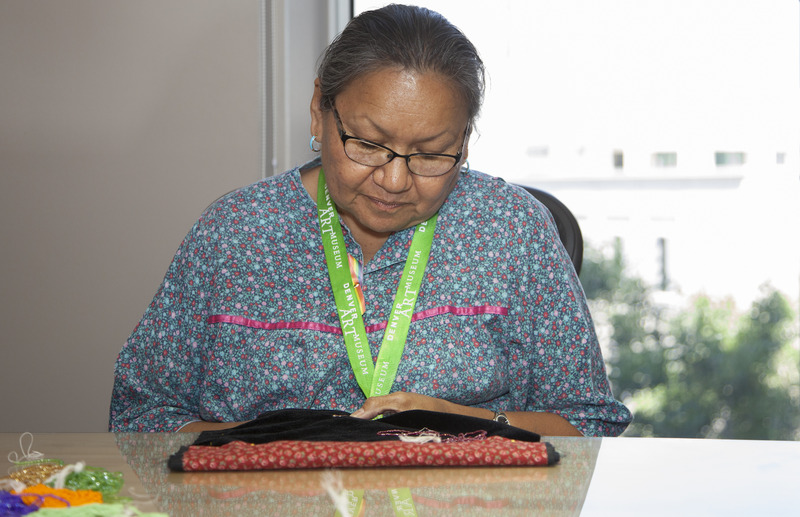The Local newsletter is your free, daily guide to life in Colorado. For locals, by locals.
Beadwork is an ancient art form that has been practiced by Native Americans for centuries. Diverse materials like shell, stone, bone, horn, metal, and brightly colored glass beads are carved, shaped, and sewn together to form intricate patterns that adorn many items, particularly clothing. The Denver Art Museum’s Why We Dance: American Indian Art In Motion (on view through August 14) showcases an incredible range of powwow regalia and the art forms, including beadwork, used to ornament them.
As part of the exhibition, the museum is hosting a Meet Native Arts Artist-In-Residence program: Six artists—specializing in their own regalia for different powwow dances—will each partake in a two-week residency at the DAM, including open studio hours. It’s an intimate way to see Native American art in process and interact with the artists. Mary Young Bear was the series’ first artist-in-residence. She is a member of the Meskwaki tribe and specializes in men’s woodland style dance. Born and raised in Denver, she now lives in Iowa, the tribe’s home.

We sat down with Mary to learn a little more about the process behind her intricate—and vibrant—beadwork.
5280: Are there any particular materials or fabrics you like to work with?
Mary Young Bear: The main surface I like to bead on is canvas that has an acrylic gesso layer on it. The surface is then easy to sew, plus it’s durable and can be made into almost anything. I also like to bead on traditional brain-tanned leather because it is also durable and it’s easy on the beading needles. [Editor’s Note: Brain-tanning is a labor-intensive process that uses animal brains and water; the result is an incredibly soft hide.] I enjoy trying new surfaces and experimenting with new beads because you never know what’s going to work until you try it. I like to tell people that there are no rules and no limitations to what we do with our art.
Do you create all of the elements for a powwow outfit?
I have learned to make almost any type of garment a dancer may need, from dresses in the three main styles of dance and the accessories that go with each style. The same goes for the men’s styles, except I do not make feather bustles or porcupine hair roaches.

Your color combinations are beautiful. How do you choose which to use?
For certain ceremonies, there are clans that require specific colors and I have to follow that rule. Any other time, it’s whatever you want, whatever you have, or what you feel like; I like to pick colors that catch my eye.
Is it the beadwork that’s customary, or the motifs?
Both. I would consider this traditional Meskwaki beadwork. The beadwork my people have made is abstracted floral motifs. So these aren’t literal leaves or flowers, just the shapes. Everything that you would see in our environment—trees, leaves, flowers, berries, animals and their tracks, vines—is inspiration.
Did you learn this art form from your mother or another family member?
I used to hang around with my grandmother. We call our grandmother Kokomas, but all the kids say Koko. I would sit with my Koko and watch her while she was beading little souvenir items to sell to supplement her income. When I was about eight years old, she taught me to do the stitch I’m doing now, which is taking four beads at a time, sewing them down, and coming up through the middle, and then you just keep going. Everything I’ve done since then comes from learning that stitch.

You mentioned ceremonial pieces; is that part of your work that’s on display (pictured, above)?
Part of it. The center mannequin and the vest at the end are mine. The vest, which I made for my son, could be worn in a ceremony, but it’s not specifically ceremonial. They’re basically regalia to be used at powwow celebrations.
Tell me more about the vest.
I wanted the designs to reflect Meskwaki floral designs. And toward the bottom of the vest, I made bear paws, because my son has a bear clan name. At the very bottom there’s an inch or so of red and green; that’s a representation of the Meskwaki tribal flag with the green on top and red at the bottom. I did that because sometimes he uses red and green paint when he dances.
Does anyone else in your family bead?
I have five kids, and they all bead. My youngest son is actually above and beyond where I’m at right now because he just fell in love with it like I did. And it should be that way. The younger people should push this art form forward because this isn’t just a craft or hobby. We put our hearts into this work. To me, anything that takes a little bit of your soul is an art. That’s always been my message every time I have an opportunity to talk: I want people to know that this is an art form.
Next up: Verla Howell, who makes men’s fancy dance bustles in the Oklahoma style, is the DAM’s current artist-in-residence. Meet her in the powwow regalia studio from 10 a.m. to 2 p.m., July 28 to 31.
—Inset images, from top: beadwork detailing courtesy of author; outfits from the powwow regalia studio courtesy of the Denver Art Museum
Follow fashion editor Georgia Benjou on Twitter at @gabenjou, Pinterest at /gabenjou, and Instagram at /gabenjou.








